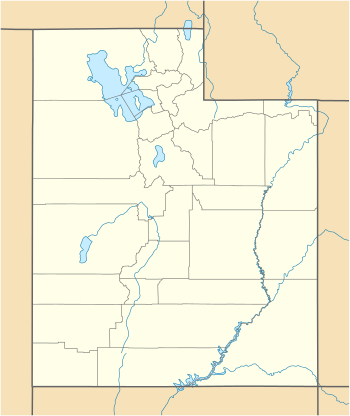Corn Creek (Millard County)
Corn Creek, also called Kanosh Creek, is a stream in Millard County, Utah. Its mouth is located in the Pahvant Valley. Its source is at the confluence of East Fork Corn Creek and West Fork Corn Creek in the Pahvant Range.[1]
| Corn Creek | |
|---|---|
 | |
| Physical characteristics | |
| Source | |
| • location | Confluence of East Fork Corn Creek and West Fork Corn Creek |
| • coordinates | 38°45′40″N 112°15′05″W |
| • elevation | 7,313 ft (2,229 m) |
| Mouth | |
• location | Kanosh |
• coordinates | 38°49′13.88″N 112°26′22.78″W |
• elevation | 4,918 ft (1,499 m) |
History
The location near the mouth of Corn Creek was originally a stopping place known as Willow Flats for the early travelers on the Mormon Road.[2][3] On January 17, 1851, George A. Smith, leader of Mormon colonists who were on their way to establish the colony at Parowan, wrote about Willow Flat to Brigham Young, that the area was, "... a prospect for a colony not to be slighted... Corn Creek sinks and forms a large meadow. The grazing is extensive; the range very good... the soil had the appearance of being very good... it seemed to suit many farmers of our camp, who would have been perfectly satisfied to have remained at that point."[4]:39, note 18
From 1851, Corn Creek was where Brigham Young, as territorial superintendent of Indian affairs for Utah, established an Indian farm for the Pahvant Indians, one of a three such farms in Utah Territory. Settlers from Fillmore grew potatoes, wheat, and corn to supplement the beans, corn, potatoes, pumpkins and squash that the Corn Creek band of Pahvants had grown at their village farther up the creek for years under their chief Kanosh. Here at Kanosh's request they were to be taught the Mormon's farming methods under the direction of a local Indian agent.[4]:44,60 The Corn Creek Indian Farm on Corn Creek existed there from 1855 to 1867, when most of its native inhabitants took down their farms and moved to the new Ute reservation, leaving the land for the new settlement of Kanosh.
In 1859, settlers from Fillmore, settled where the Mormon Road crossed the creek northwest of the Corn Creek village and farm. It was named for Peter Robison, its first post master, Petersburg (1859-1877). Petersburg was one of the larger stations and rest stops on the Gilmer and Salisbury Stage Company line from the Utah Central Railroad and Utah Southern Railroad rail head to the mining boom town of Pioche, Nevada from 1864 to 1871. From 1877 to 1940, an agricultural settlement there had a post office called Hatton. This settlement is now a ghost town, with little to see of its past existence among the irrigated fields.[5]:179[4] :86, 99–101, 114–117, 124, 129–130
See also
References
- U.S. Geological Survey Geographic Names Information System: Corn Creek
- Hafen, LeRoy Reuben; Hafen, Ann Woodbury (1998). Journals of Forty-niners: Salt Lake to Los Angeles : with Diaries and Contemporary Records of Sheldon Young, James S. Brown, Jacob Y. Stover, Charles C. Rich, Addison Pratt, Howard Egan, Henry W. Bigler, and Others. University of Nebraska Press. p. 321. ISBN 0-8032-7316-9. Road distances from readings of roadometer attached to the wagon of Addison Pratt of the 1849 Jefferson Hunt Wagon Train.
- Randolph Barnes Marcy (1859). "Itinerary VI. From Great Salt Lake City to Los Angeles and San Francisco, California". The Prairie Traveler. A Hand-Book for Overland Expedition. By Authority of the War Department. Retrieved May 22, 2015 – via Kansas Collection website.
- Edward Leo Lyman; Linda King Newell (1999). A History Of Millard County. Utah State Historical Society, Millard County Commission.
- John W. Van Cott (1990). Utah Place Names: A Comprehensive Guide to the Origins of Geographic Names: a Compilation. Salt Lake City: University of Utah Press.